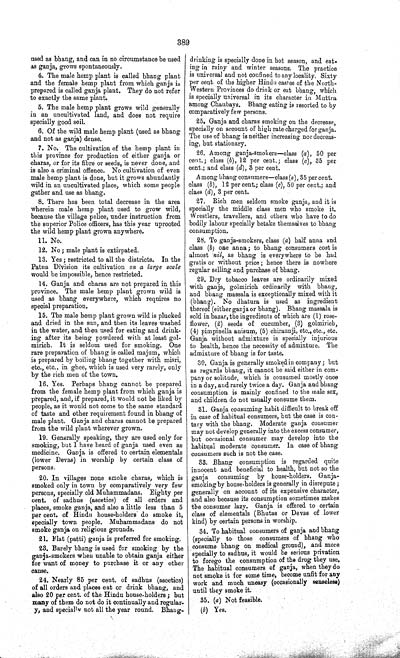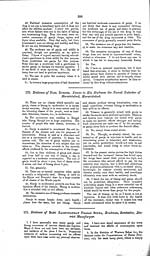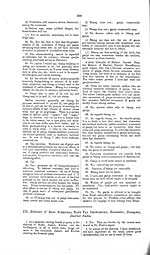Medicine - Drugs > Report of the Indian Hemp Drugs Commission, 1894-1895 > Volume IV
(403) Volume 4, Page 389
Thumbnail gallery: Grid view | List view

389
used as bhang, and can in
no circumstance be used
as ganja, grows spontaneously.
4. The male hemp
plant is called bhang plant
and the female hemp plant from which ganja is
prepared is called ganja plant. They do not refer
to exactly the same plant.
5. The male hemp
plant grows wild generally
in an uncultivated land, and does not require
specially good soil.
6. Of the wild male
hemp plant (used as bhang
and not as ganja) dense.
7. No. The
cultivation of the hemp plant in
this province for production of either ganja or
charas, or for its fibre or seeds, is never done, and
is also a criminal offence. No cultivation of even
male hemp plant is done, but it grows abundantly
wild in an uncultivated place, which some people
gather and use as bhang.
8. There has been
total decrease in the area
wherein male hemp plant used to grow wild,
because the village police, under instruction from
the superior Police officers, has this year uprooted
the wild hemp plant grown anywhere.
11. No.
12. No; male plant is extirpated.
13. Yes; restricted
to all the districts. In the
Patna Division its cultivation on a large scale
would
be impossible, hence restricted.
14. Ganja and
charas are not prepared in this
province. The male hemp plant grown wild is
used as bhang everywhere, which requires no
special preparation.
15. The male hemp
plant grown wild is plucked
and dried in the sun, and then its leaves washed
in the water, and then used for eating and drink-
ing after its being powdered with at least gol-
mirich. It is seldom used for smoking. One
rare preparation of bhang is called majum, which
is prepared by boiling bhang together with misri,
etc., etc., in ghee, which is used very rarely, only
by the rich men of the town.
16. Yes. Perhaps
bhang cannot be prepared
from the female hemp plant from which ganja is
prepared, and, if prepared, it would not be liked by
people, as it would not come to the same standard
of taste and other requirement found in bhang of
male plant. Ganja and charas cannot be prepared
from the wild plant wherever grown.
19. Generally
speaking, they are used only for
smoking, but I have heard of ganja used even as
medicine. Ganja is offered to certain elementals
(lower Devas) in worship by certain class of
persons.
20. In villages
none smoke charas, which is
smoked only in town by comparatively very few
persons, specially old Muhammadans. Eighty per
cent. of sadhus (ascetics) of all orders and
places, smoke ganja, and also a little less than 5
per cent. of Hindu house-holders do smoke it,
specially town people. Muhammadans do not
smoke ganja on religious grounds.
21. Flat (patti) ganja is preferred for smoking.
23. Barely bhang is used
for smoking by the
ganja-smokers when unable to obtain ganja either
for want of money to purchase it or any other
cause.
24. Nearly 85 per cent.
of sadhus (ascetics)
of all orders and places eat
or drink bhang, and
also 20 per cent. of the
Hindu house-holders; but
many of them do not do it
continually and regular-
y, and specially not all the
year round. Bhang-
drinking is specially
done in hot season, and eat-
ing in rainy and winter seasons. The practice
is universal and not confined to any locality. Sixty
per cent. of the higher Hindu castes of the North-
Western Provinces do drink or eat bhang, which
is specially universal in its character in Muttra
among Chaubays. Bhang eating is resorted to by
comparatively few persons.
25. Ganja and
charas smoking on the decrease,
specially on account of high rate charged for ganja.
The use of bhang is neither increasing nor decreas-
ing, but stationary.
26. Among
ganja-smokers—class (a), 50 per
cent.; class (b), 12 per cent.; class (c), 35 per
cent.; and class (d), 3 per cent.
Among bhang
consumers—class (a), 35 per cent.
class (b), 12 per cent.; class (c), 50 per cent.;
and
class (d), 3 per cent.
27. Rich men
seldom smoke ganja, and it is
specially the middle class men who smoke it.
Wrestlers, travellers, and others who have to do
bodily labour specially betake themselves to bhang
consumption.
28. To
ganja-smokers, class (a) half anna and
class (b) one anna; to bhang consumers cost is
almost nil, as bhang is everywhere to be had
gratis or without price; hence there is nowhere
regular selling and purchase of bhang.
29. Dry tobacco
leaves are ordinarily mixed
with ganja, golmirich ordinarily with bhang,
and bhang massala is exceptionally mixed with it
(bhang). No dhatura is used as ingredient
thereof (either ganja or bhang). Bhang massala is
sold in bazar, the ingredients of which are (1) rose-
flower, (2) seeds of cucumber, (3) golmirich,
(4) pimpinella anisum, (5) chiraunji, etc., etc., etc.
Ganja without admixture is specially injurious
to health, hence the necessity of admixture. The
admixture of bhang is for taste.
30. Ganja is
generally smoked in company; but
as regards bhang, it cannot be said either in com-
pany or solitude, which is consumed mostly once
in a day, and rarely twice a day. Ganja and bhang
consumption is mainly confined to the male sex,
and children do not usually consume them.
31. Ganja consuming habit
difficult to break off
in case of habitual consumers, but the case is con-
tary with the bhang. Moderate ganja consumer
may not develop generally into the excess consumer,
but occasional consumer may develop into the
habitual moderate consumer. In case of bhang
consumers such is not the case.
33. Bhang
consumption is regarded quite
innocent and beneficial to health, but not so the
ganja consuming by house-holders. Ganja-
smoking by house-holders is generally in disrepute;
generally on account of its expensive character,
and also because its consumption sometimes makes
the consumer lazy. Ganja is offered to certain
class of elementals (Bhutas or Devas of lower
kind) by certain persons in worship.
34. To habitual
consumers of ganja and bhang
(specially to those consumers of bhang who
consume bhang on medical ground), and more
specially to sadhus, it would be serious privation
to forego the consumption of the drug they use.
The habitual consumers of ganja, when they do
not smoke it for some time, become unfit for any
work and much uneasy (occasionally senseless)
until they smoke it.
35. (a) Not feasible.
(b) Yes.
Set display mode to: Large image | Zoom image | Transcription
Images and transcriptions on this page, including medium image downloads, may be used under the Creative Commons Attribution 4.0 International Licence unless otherwise stated. ![]()
| India Papers > Medicine - Drugs > Report of the Indian Hemp Drugs Commission, 1894-1895 > Volume IV > (403) Volume 4, Page 389 |
|---|
| Permanent URL | https://digital.nls.uk/74553056 |
|---|---|
| Description | Evidence of Bengal witnesses. |
| Description | Volume 4: Evidence of witnesses from Bengal and Assam. |
|---|---|
| Attribution and copyright: |
|




